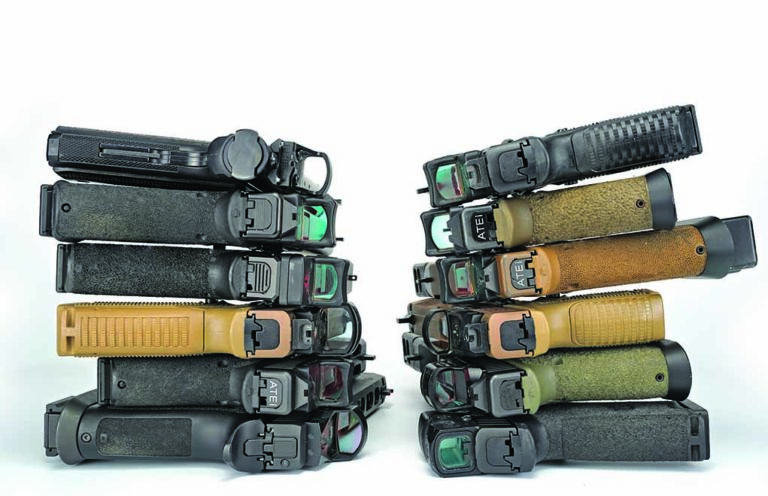
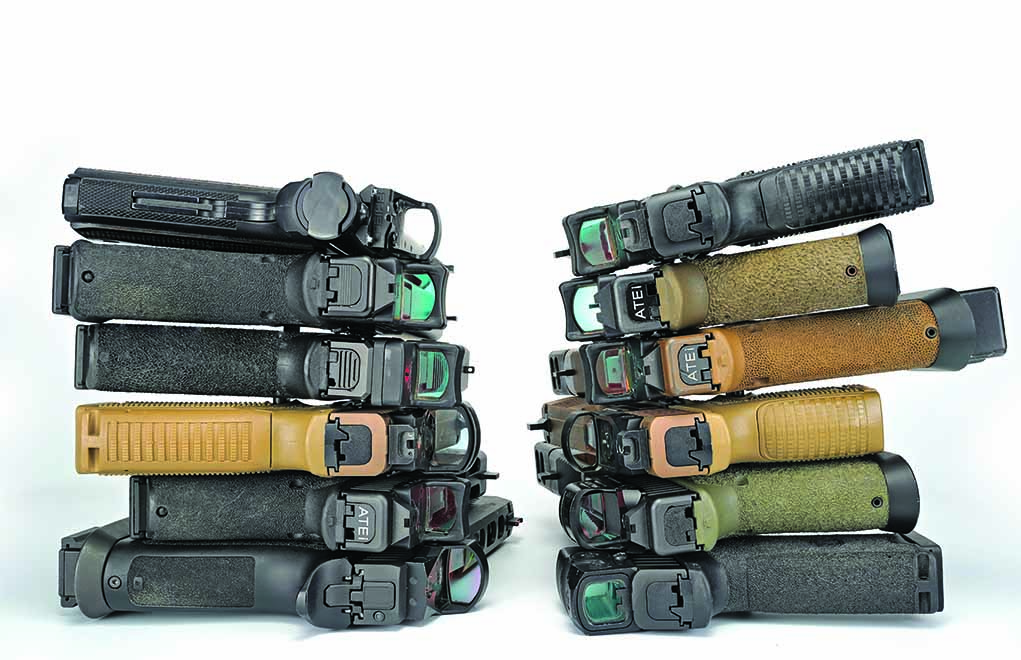
If your aim is accuracy, it's high time to add a red-dot sight to your pistol.
Carrying a semi-auto pistol with a mini red-dot sight (MRDS) isn’t as uncommon as it used to be. Still, plenty of naysayers are out there with cries of how it’ll get you “kilt in da skreets,” but that isn’t as common anymore thanks to advancements in technology. Over the past decade, mini red-dot sights have been used in the most demanding environments by elite law enforcement officers, members of special operations, and legally armed civilians.
There are a ton of benefits that can’t be ignored and outweigh the negatives by a large margin, but there are some things that you should know before you jump into the MRDS world. Not all mini red-dot sights are created equal.
Why Switch?
Finer Aiming Point: Iron sights aren’t as precise an aiming system as you might think, regardless of how “high speed” they are. Even the largest red dot on the market covers less target area than nearly every iron sight out there.
For example, a set of Dawson Precision adjustable irons on a Glock 17L still covers five times more target area at 25 yards than a 3.25 MOA red dot. Combat-focused sights, such as the XS Sights DXT Big Dots, exacerbate the shortcoming, especially on tiny pistols like in the Glock 26 category. In that particular example, the front post will cover roughly 10 times more target area than the Trijicon RMR RM06.

Better in Low Light Conditions: For years, tritium night sights were the accepted “must have” for a defensive pistol until more recently when advancements in weapon-mounted lights made the tritium night sight less irrelevant. Now, one of the most accepted iron sights for defensive use are competition-oriented black rear/fiber-optic front sights. Not only is a dot easier to acquire in low light, but it performs just as well when paired with a weapon light.
You Will be Faster … Eventually
Is an MRDS going to turn you into John Wick? No. What a mini red dot will bring to the table is fewer things to process to place an effective shot on a threat under pressure. There’s a learning curve, so don’t fool yourself into thinking that performance comes as soon as you bolt the dot to your slide.
Like many new red-dot converts, you’ll almost certainly fish for the dot while presenting the pistol. The reason for that is the iron sights that your mind is aligning subconsciously as the gun is presented are no longer the most prominent thing on the top of the slide. With some practice, the dot appears in front of you as if it was magic, and your first shot from a draw will be faster than ever as long as you don’t over confirm your sight picture.
Moving targets are also going to be easier to engage accurately. Few things are as challenging as shooting a mover with irons. Why not remove the need to align your irons and focus on tracking your target?
Choosing a Dot
Dot Size: Depending on who you ask, the size of your red dot either matters or doesn’t matter at all. There are several dot sizes to choose from, ranging from a 1 MOA dot up to a 12.9 MOA triangle reticle.

You might choose something like a 3.25 MOA dot if you’re looking for a good mix of precision and speed. If you want to pump up the speed, add some brightness to make the dot bloom and appear bigger.
There are good reasons to go with a larger 6.5 MOA dot, such as getting all of the speed benefits of the larger dot without having to increase the brightness at the cost of battery life. The larger dots are also better when transitioning from dark to light environments when using a weapon light and will be easier for a new red-dot shooter to find after the pistol recoils.
If you have astigmatism or poor eyesight, the Holosun’s 32 MOA circle reticle with a 2 MOA center dot might be the best decision for you—or even the triangle reticles found on some Trijicon RMR and Leupold DeltaPoint Pro models.
Footprint: While the optic mount might not seem important, don’t limit yourself as you grow as a shooter. Setting a slide up for a red dot isn’t an inexpensive prospect, so why not give yourself some options?

There are several footprints available, but the market is dominated by the RMR, DeltaPoint Pro, and Holosun HS507K footprints. Outside of those, there are some relevant optics like the Holosun HS509T and Aimpoint’s excellent ACRO that should be on your shortlist.
The Trijicon RMR footprint is quickly becoming the industry standard for mini red-dot sights and has been the most popular for some time. Should you choose the RMR footprint, the choices are seemingly endless with all of Trijicon’s proven options, as well as the robust Holosun mini red-dot sight family.
Less popular than the RMR footprint is the Leupold DeltaPoint Pro footprint, largely due to the Department Of Defense clinging to it as a mounting standard. There are some dots out there in this footprint that should be on the list of considerations, such as the DeltaPoint Pro. Sig Sauer has some optics that are designed for this cut.
Zero In On Aiming Solutions:
- Best Concealed Carry Optics: Red Dot, Green Dot Or Iron Sights?
- 7 Out-Of-Sight Optics For Every Range And Budget
- Red Dot Optics And MOA
- Gear: Lighting It Up With A Laser Sight
Durability: When selecting a red dot, consider if that optic is durable enough to handle the rigors of being carried. While many shooters justify subpar optics by telling themselves that they “just won’t drop their gun,” anything can happen if you need to use your firearm for self-defense.
Another factor to consider is weather resistance, from rain to submersion and temperature fluctuations. Some models are surprisingly prone to fogging, which can be mitigated with anti-fog coatings like Cat Crap. You might not think choosing an optic capable of working after being submerged is important, but being prepared is what self-defense is all about.
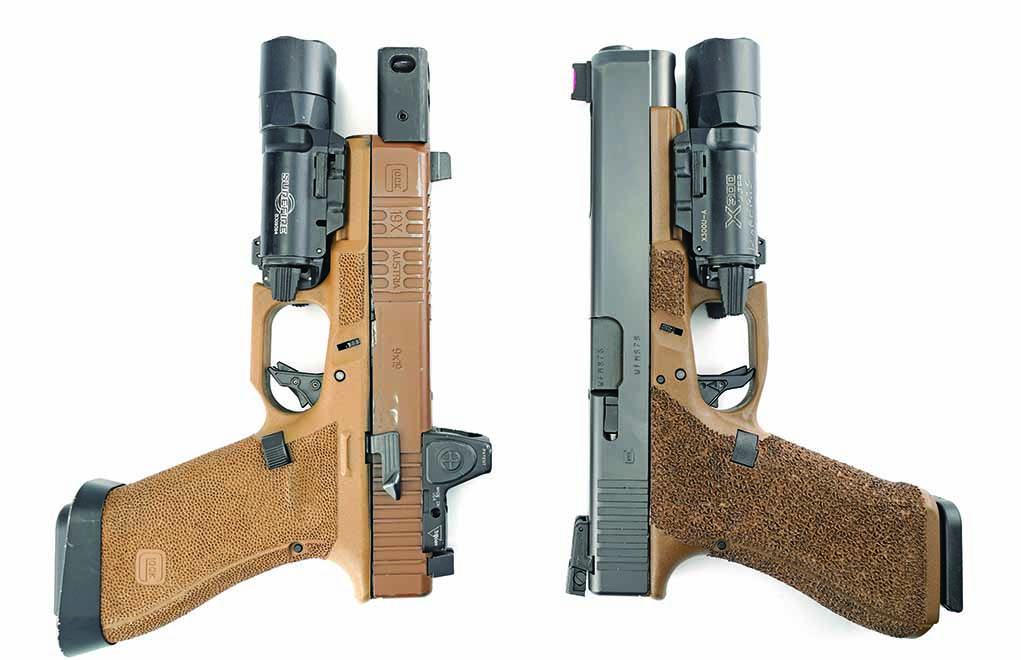
Direct-Milled Slides: Just like the red dot itself, slide-mounting systems are not created equal. Direct milling will always be more secure, MOS-style systems will always have drawbacks, and there are some systems that are a hybrid of the two, giving you incredible flexibility without sacrificing.
Having your slide milled for your specific optic is by far the most preferred solution. Not all direct milling is on the same level, though; you absolutely get what you pay for. I don’t know about you, but I’m not about to skimp and potentially ruin a slide that can cost upward of $350 to replace because I was cheap and sent my slide to a bargain shop.
MOS and Other Factory Mounts
Like mentioned previously, the MOS-style system is the most prevalent on the market currently. That isn’t because it’s the best; it’s because it works well enough for most. Plate-style MOS systems all can trace their roots back to the FN FNP-45 Tactical, which later became the FNX-45 Tactical. If the fact that FN developed an entirely new mount system isn’t evidence enough that the plate-style system has drawbacks, I don’t know what is.
Since you’re screwing a plate to your slide and then screwing an optic to the plate, there isn’t a good way to check to see how tight the plate-to-slide screws are over time. In testing, the most rounds I was able to shoot before the plate to slide screws started becoming loose was 1,200 rounds.
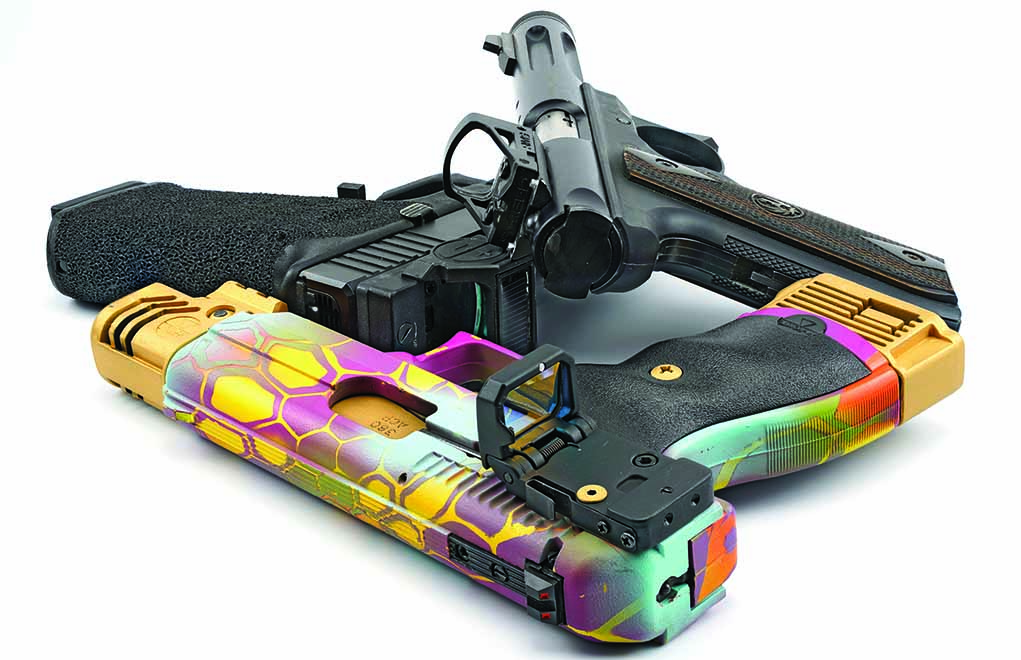
The new FN mounting system is the best factory option I’ve seen to date. There’s no need for thread-locker; you can adapt it to multiple optics’ footprints, and it’ll hold zero for thousands of rounds. In the more than 17,000 rounds of testing of FN 509 MRD variants, I’ve yet to see an optic lose zero due to loosening.
Sig also has some rather attractive mounting options from the factory, including their DeltaPoint Pro compatible Romeo1 Pro cut. Some of the P320s even have a hybrid cut that allows the shooter to mount either DeltaPoint Pro footprint optics or Trijicon RMR footprint optics.
Aftermarket Mounts
There are some aftermarket solutions, like the outstanding Agency Arms AOS system or Unity Tactical’s ATOM mount, that are on the same playing field as a direct-milling solution.
Others, like the Dueck Defense RBU and Raven Concealment’s BALOR RDS mount, can offer a no-modification solution that I’d personally be comfortable with carrying for defensive reasons. You should avoid knockoffs of the RBU and the BALOR mounts, as they have proven to not hold up to the demands of being carried.

The discontinued ALG Defense 6-Second Mount is a frame-mounted solution that allows you to choose with the proven Trijicon RMR or the even more robust Aimpoint T-1. While robust and ready for defensive use, they’re too large to consider for daily carry.
If you’re averse to modifying your pistol slide, there are some mounting solutions that you should avoid: A dovetail mount is a great tool to see if you want to invest the time in the switch to an MRDS, but it isn’t robust enough for defensive use. Also, be very cautious of online pop-up deals. Remember what’s at stake.
Odds and Ends
Zeroing Your MRDS: Opinions vary on what distance you should confirm your zero, both the 15- and 25-yard zeros have their merits. What you choose depends on the barrel length of your gun and your load choice. Personally, there’s only one distance I consider when zeroing my red dots for both defensive and target shooting purposes: 25 yards. When using an NRA B8 repair center as our reference target, the bullet will stay in the X-ring—when I do my part as a shooter—from 3 yards out to 50 yards.
Battery Changes: Get on a schedule that makes sense for the power consumption of your preferred brightness level and the capacity of the battery used in your optic. With batteries ranging from the tiny CR1225 with a 50mAh capacity up to the significantly larger CR2032 with a whopping 235mAh capacity, battery life can be as short as a month to several years.
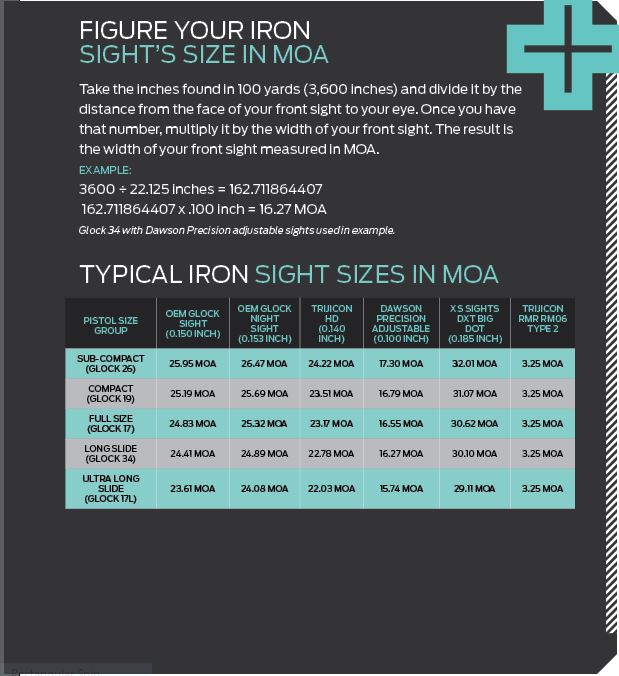
With my Trijicon RMRs and Holosun optics, the battery change happens once a year on my birthday, even though they’d likely be good for another year or two. Other optics vary depending on how often that gun is shot, and if it’s used as a carry gun. Don’t shy away from a great optic because the internet doesn’t understand battery limitations—just alter your battery change schedule to complement your optic choice.
Anti-Fog Goop: I like air conditioning, but I don’t like how the glass of my optic will fog up if I take it from the brisk 68 degrees in my truck to the sweltering 110-degree humid summer day at an outdoor range. Treating your lens with a product like Cat Crap will mitigate fogging issues, as well as ensure water and debris don’t stick to the glass or the emitter window. Regularly clean the parts of your optic that transmit and project the dot … and make sure you treat those areas.
The Bottom Line on Dots
While I’m still very competent with iron sights, I’ll shoot a red-dot-equipped pistol 10 times out of 10 when given a choice. The math just doesn’t lie. As long as you practice, you’ll shoot better … and you’ll be faster.
Editor's Note: This article originally appeared in the October 2020 issue of Gun Digest the Magazine.

Next Step: Get your FREE Printable Target Pack
Enhance your shooting precision with our 62 MOA Targets, perfect for rifles and handguns. Crafted in collaboration with Storm Tactical for accuracy and versatility.
Subscribe to the Gun Digest email newsletter and get your downloadable target pack sent straight to your inbox. Stay updated with the latest firearms info in the industry.

![Best Concealed Carry Guns In 2025 [Field Tested] Wilson Combat EDC X9S 1](https://gundigest.com/wp-content/uploads/Wilson-Combat-EDC-X9S-1-324x160.jpg)


![Best 9mm Carbine: Affordable PCCs [Tested] Ruger Carbine Shooting](https://gundigest.com/wp-content/uploads/Ruger-Carbine-Shooting-100x70.jpg)
![Best AR-15: Top Options Available Today [Field Tested] Harrington and Richardson PSA XM177E2 feature](https://gundigest.com/wp-content/uploads/Harrington-and-Richardson-PSA-XM177E2-feature-100x70.jpg)

I just bought a HOLOSUN 509T circle/dot fully enclosed sight for my RUGER 57 pistol. My gunsmith is drilling and countersinking holes in the included mounting plate to adapt it to my RUGER 57 slide.
For a pistol chambered in that 5.7 x 28 flat shooting cartridge the circle reticle gives me a reference point for long distance (100 yards) shots of which that pistol is fully capable.
We will see, I’m sure, several other sight makers selling fully enclosed red dot sights. But few, if any, will have all the features of the HOLOSUN 509T. AIMPOINT, are you worried?
Also, once you hit your mid/late-40s, a red dot is much, much easier to line up with a target than are iron sights.
A lot of people claim that a red dot is harder to acquire when raising a pistol that iron sights. This is simply not true. It appears true b/c people indiscriminately raise the pistol hoping to see the red dot, which is just like raising the pistol indiscriminately and hoping to find front and rear sights aligned. On the other hand, if you raise that pistol as if you were going to look thru front & rear iron sights, guess what … you’ll see the red dot, and without having to align it to a second component on the pistol.